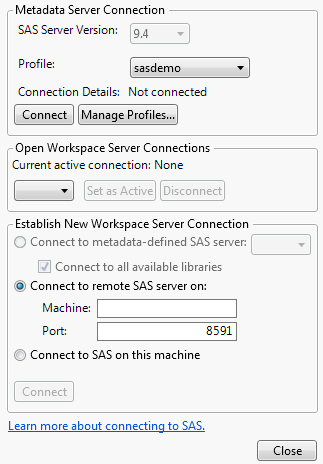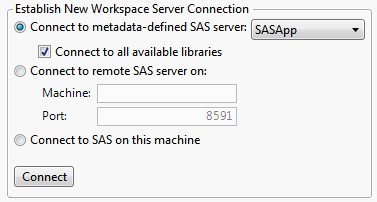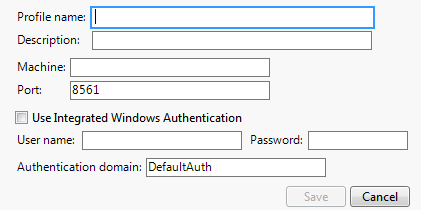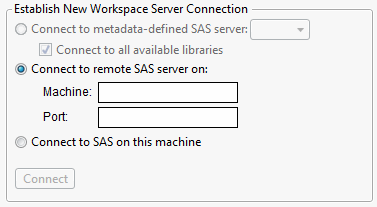Connect to SAS from JMP
You can either connect to a SAS Metadata Server or directly to a SAS Workspace Server. Once connected to a SAS Metadata Server, you can browse through SAS servers, libraries, and data sets.
Note: SAS Server version 9.4 is the default setting in the JMP SAS Integration preferences though you can change the version to 9.3 if necessary.
To begin, select File > SAS > Server Connections. The SAS Server Connections window shown in Figure 3.51 appears. All connections are made in this window.
Figure 3.51 SAS Server Connections
The following sections describe how to connect to a SAS server.
• Connect to a SAS Metadata Server from JMP
• Connect to a Remote SAS Workspace Server from JMP
• Connect to a SAS Environment from JMP (Windows Only)
• Connect to SAS on Your Local Machine from JMP (Windows Only)
Connect to a SAS Metadata Server from JMP
Note: You can be connected to only one Metadata Server at a time. If you make a second connection, your first one is disconnected.
To connect to a Metadata Server
1. Select File > SAS > Server Connections. The SAS Server Connections window shown in Figure 3.51 appears.
2. Select the version for the SAS Server. Your SAS Metadata Server administrator should have this information.
SAS Server version 9.4 is selected by default based on the JMP SAS Integration preferences.
3. Select the profile that you want to use.
If you do not have a profile set up, see To create or modify a SAS Metadata Server profile.
4. Click Connect.
If JMP is unable to establish a connection, an error message appears. Common reasons are invalid user names or passwords. If you need to update the information for the profile, see To create or modify a SAS Metadata Server profile.
5. Click Close.
Once you are connected to a SAS Metadata Server, you can connect to any SAS Workspace Servers that the Metadata Server offers.
To connect to a SAS Workspace Server (Windows only)
1. Select File > SAS > Server Connections. The SAS Server Connections window shown in Figure 3.51 appears.
2. Select the Workspace Server to connect to.
Figure 3.52 Open a Connection to a Workspace Server
3. Click Connect.
Under Open Workspace Server Connections, the Workspace Server is shown as the current active connection.
Figure 3.53 Current Active Connection
4. Click Close.
To change the active connection
Note: The active connection is what is used to submit SAS code or handle SAS script commands.
To change the active connection, you first need to be connected to more than one server. Follow the instructions in To connect to a SAS Workspace Server (Windows only) to add two or more server connections.
1. In the Open Workspace Server Connections section, click the drop-down menu and select the desired server.
2. Click Set as Active.
3. Click Close.
Tip: You can change the active server at any time.
To disconnect from a SAS Workspace Server
1. In the SAS Server Connections window, select the Workspace Server to disconnect under Open Workspace Server Connections.
2. Click Disconnect.
To disconnect from a SAS Metadata Server
1. In the SAS Server Connections window, select the Metadata Server to disconnect.
2. Click Disconnect.
To create or modify a SAS Metadata Server profile
1. In the SAS Server Connections window, select the SAS Server Version.
2. Click Manage Profiles.
3. Click Add to add a new profile, or click Modify to change a profile’s settings.
The Create Profile or Modify Profile window appears. If you are adding a new profile, all fields are empty except the Authentication domain field, which contains DefaultAuth, and the Port field. If you are modifying a profile, the fields contain the current information.
Figure 3.54 Create or Modify a Metadata Server Profile
4. Fill in the information needed to connect to a SAS Metadata Server. Your SAS Metadata Server administrator should have this information.
Profile name
Select a name for this profile. This name is shown in the list of profiles.
Description
(Optional) You can enter a short description of this profile.
Machine
The name of the machine that hosts the Metadata Server. (Example: myserver.mycompany.com)
Port
The port through which you should connect to the machine. (Example: 8561)
Use Integrated Windows Authentication
Select this option to use your Windows log in ID and password to access the server. When enabled, the User name and password fields are disabled. This option is disabled by default.
User name
Your user name for the Metadata Server.
Password
Your password. This is always displayed as asterisks.
Authentication domain
The domain you, as a user, belong to.
5. Click Save.
Connect to a Remote SAS Workspace Server from JMP
You can also connect directly to a SAS Workspace Server, instead of going through a Metadata Server.
To connect to a Remote SAS Workspace Server
1. Select File > SAS > Server Connections. The SAS Server Connections window shown in Figure 3.51 appears.
2. Under Establish New Workspace Server Connection, select Connect to remote SAS server on.
Figure 3.55 Open a Connection to a Remote SAS Server
3. Enter the machine name and the port number. Your SAS server administrator has this information.
4. Click Connect.
5. Enter your user name and password in the window that appears.
6. Click OK.
7. Click Close in the SAS Server Connections window.
To disconnect from a Remote SAS Workspace Server
1. In the SAS Server Connections window, select the server to disconnect under Open Workspace Server Connections.
2. Click Disconnect.
Connect to a SAS Environment from JMP (Windows Only)
On Windows, you can connect to a SAS mid-tier (or SAS environment) if SAS Server version 9.3 or 9.4 is selected in JMP’s preferences and your computer or JMP has been configured correctly. (SAS Server version 9.4 is the default setting in the JMP SAS Integration preferences.)
The SAS installer should have set up your computer to find the SAS environment definition file. If not, you can enter the path to the file in the JMP preferences.
To configure your JMP preferences
1. Select File > Preferences > SAS Integration.
2. Select I want to connect to a SAS Environment and then click Configure.
3. To connect to an environment that JMP has already detected, click Automatic discovery, and then select the URL from the list if necessary.
4. To enter the path to the SAS environment definition file, click Manual configuration and enter the URL.
5. Click OK.
To connect to a SAS Environment
1. Select File > SAS > Server Connections to open the SAS Server Connections window.
2. In the Metadata Server Connection area, select Connect to a SAS Environment.
If this option is not available, either your computer or JMP is not configured to find the environment. See To configure your JMP preferences.
3. Select the name of the environment from the Environment list if necessary.
4. Click Connect.
5. Enter your user name and password if prompted.
Connect to SAS on Your Local Machine from JMP (Windows Only)
You can also connect directly to SAS on your local machine.
To connect to SAS on your computer
1. Select File > SAS > Server Connections to open the SAS Server Connections window.
2. Under Establish New Connection, select Connect to SAS on this machine.
This option is disabled if SAS is not installed on the computer.
3. Click Connect.
4. Click Close in the SAS Server Connections window.
To disconnect from SAS on your computer
1. In the SAS Server Connections window, select Local under Open Connections.
2. Click Disconnect.




